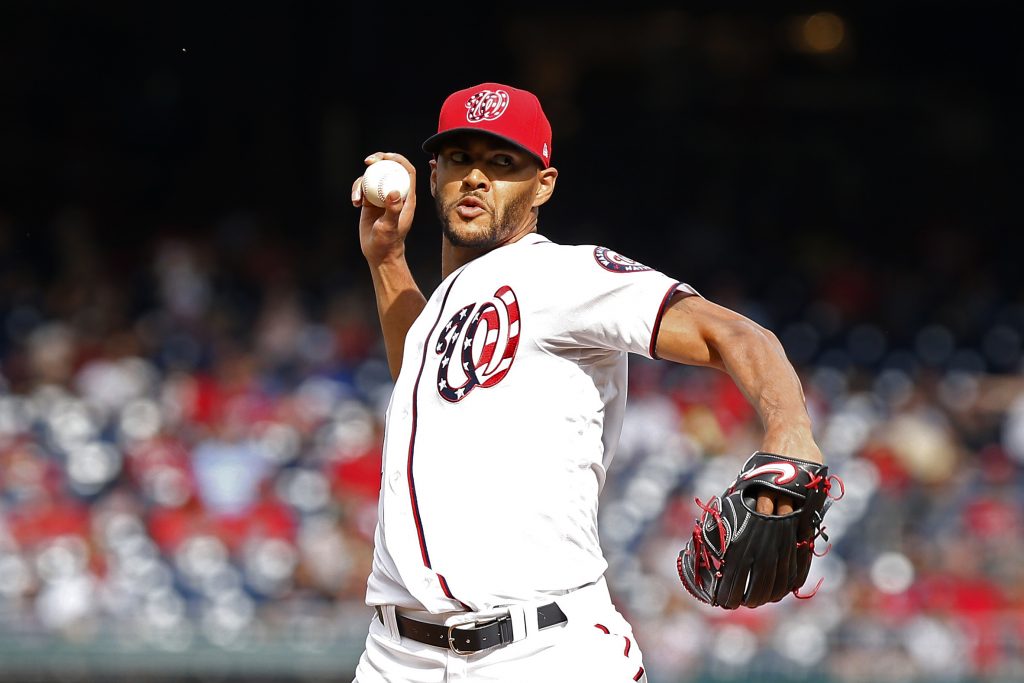
The Nationals continue to lean Joe Ross’ direction for their fifth starter spot, per Jesse Dougherty of the Washington Post (via Twitter). The Nats’ organization has long been enamored with Ross’ potential. But it’s been a long and winding road.
Injuries and poor performance had all but done in Ross in the first half of 2019. Austin Voth and Erick Fedde were both getting starts ahead of him, and a stint as a long man out of the pen proved disastrous. He posted an 11.17 ERA/6.27 FIP in 19 1/3 innings out of the bullpen. A .415 BABIP didn’t help matters, nor did Freddie Freeman and the Braves, who blew him up for four earned runs in one inning on June 22nd, an outing that resulted in Ross’ demotion to the minors.
Then, with the Nats playing like one of the best teams in baseball, ace Max Scherzer missed the first three weeks of August. Ross stepped in. Surprisingly, he didn’t miss a beat. He made eight starts the rest of the way with a 2.75 ERA over 39 1/3 innings. The Nats went 7-1 in those games.
What Ross found, and what the Nats saw in him, wasn’t just a solid stretch of games. It was a return to his roots. He came into the league in 2015 as a two-pitch pitcher: sinker and slider. He added a change-up for 2016. Over those first two seasons, he had a 3.52 ERA/3.46 FIP over 181 2/3 innings. But injuries piled up, culminating in Tommy John surgery in 2017. He made just 16 starts in 2017-18 covering 89 2/3 innings with a 5.02 ERA/5.14 FIP.
Those were injury-riddled seasons, but something else happened those two seasons. Ross started to re-work his pitch mix, relying less on his sinker. Instead of 54% sinkers, 38% sliders, and 8% change-ups, Ross threw 47% sinkers, 35% sliders, 11% change-ups, and 8% four-seamers. In three starts after returning from Tommy John in 2018, however, his four-seam usage jumped to 30.4% – his most-used offering.
Ross started the same way in 2019 – with lots of fastballs. Over the final two months, however, he returned to a sinker-heavy approach, dropping his fastball usage to 15.1% in August and 21.6% in September. It took Ross awhile to find his sinker again after returning from injury, but he found it in August 2019.
His fastball, of course, does serve a function. It has the potential to be a better swing-and-miss offering than his sinker. His heater generated a 22.8% swing-and-miss rate in 2019 to just 14.9% on his sinker. His most important pitch might be his change-up, an area of specialty for new pitching coach Jim Hickey.
After opting out of the 2020 season, Ross made his first spring start yesterday, tossing 39 pitches against the Mets. Ross spoke about rushing, missing high with his fastball, and trying to focus on his change-up, per MLB.com’s Jessica Camerato.
Manager Davey Martinez hopes to get him closer to 50 pitches in his second outing. If Ross can build up his stamina and avoid injury, he’s going to be the Nats’ fifth starter. The inside track is his.
From the outside, it’s easy to see Ross’ 5.21 ERA/4.91 FIP since 2017, and question whether he’s the best option. But the decision-makers in Washington likely remember the best of Ross. Martinez leaned on him down the stretch in their title-winning season. He called on Ross the morning of game five and pushed him into emergency duty, again, when Scherzer woke up unable to lift his arm. The Nats lost that game, but Ross gave them five innings just two days after throwing 19 pitches in game three.
GM Mike Rizzo knows the best parts of Ross as well. He is, after all, the GM who acquired him. What’s more, the deal that brought Ross to Washington is one of the most successful trades on Rizzo’s lengthy resume. That was the same deal that would eventually deliver Trea Turner as a player to be named later.
There’s a lot of history there. Ross was 21-years-old when Rizzo acquired him. The Nationals have invested a lot of time into his development, and if he can be the guy the organization thinks he can be, he’ll be a steal while making just $1.5MM in 2021. He even has one season of arbitration remaining after 2021.
In tracing Ross’ journey with Rizzo over these past six years, it’s easy to see just how muddying the human element of the game can be. One could look at the projections for Ross, 1.1 fWAR by STEAMER, 0.5 fWAR by ZiPS, and see not much upside. Especially for a Nats’ team that hopes to return to contention in a crowded NL East. For Rizzo, Martinez, and Ross, however, the upside is more than a few wins above replacement. It’s redemption. It’s mentorship and perseverance and the culture of their club. It’s validation all around.
Over the past couple of years, the Nats made headlines by letting superstars Bryce Harper and Anthony Rendon walk in free agency. But as an organization, the Nats like to believe in their people. Ask Ryan Zimmerman, who’s been with the team for 15 years. Or Aaron Barrett, whom the Nats helped return to the bigs after a four year absence and two gruesome injuries. Or even Stephen Strasburg, whom the Nats famously tried to protect by keeping him out of the playoffs because they believed that was best for his long-term health.
It’s not surprising, then, that the Nationals want to believe in Ross. They’re going to give him every opportunity to break camp as their fifth starter. He’s also out of options, which serves as a nice metaphor while also describing his roster status. If he’s not able to put it all together this season, Rizzo and the Nats might finally move on, as they’ve proven themselves capable of doing. But for now, he’s their guy.
